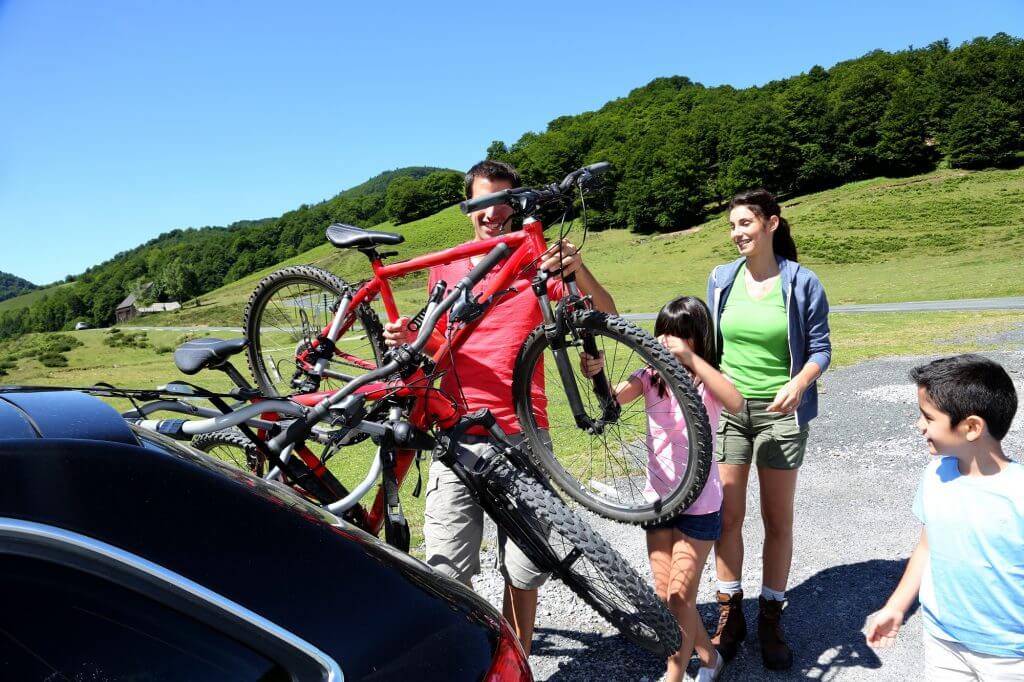
Carbon fiber bicycles are marvels of modern engineering – incredibly lightweight, impressively stiff, and often sculpted into aerodynamic masterpieces. They represent a significant investment for passionate cyclists. Naturally, transporting such a prized possession on your SUV requires careful consideration to prevent any damage. This brings us to a common question for SUV owners who may not have a hitch installed: are trunk mount bike racks a safe option for carbon fiber bikes?
The allure of a trunk-mounted bike carrier is understandable. They are generally more affordable than installing a hitch and purchasing a hitch mount rack, and they offer a convenient way to transport bikes for occasional outings. However, when it comes to the unique properties of carbon fiber, the answer to their safety isn’t a simple yes or no. This guide will delve into the specifics, helping you make an informed decision to protect your investment.
Understanding Carbon Fiber’s Unique Nature
Before we assess trunk racks, it’s vital to understand why carbon fiber requires special handling. Carbon fiber isn’t like metal. It’s a composite material made of carbon fibers woven together and set in resin. This construction provides incredible tensile strength (resistance to being pulled apart) and stiffness in the directions the fibers are laid, all while being exceptionally light.
However, carbon fiber can be vulnerable to:
- Clamping Forces: Unlike aluminum or steel, which might dent under excessive clamping pressure, carbon fiber can crack or crush. This damage isn’t always visible externally but can compromise the frame’s structural integrity.
- Impact Damage: Sharp impacts can cause delamination (separation of the carbon layers) or fractures.
- Abrasion: While the resin provides some protection, repeated rubbing or abrasion can wear through the protective layers and into the fibers themselves.
These vulnerabilities are precisely why cyclists often cringe at the thought of anything but the most secure and gentle transport methods. As bicycle manufacturer Trek Bikes notes in their carbon care guide, “Incorrect clamping can cause frame damage that may or may not be visible. A damaged frame can fail suddenly, causing serious injury or death.” This advice underscores the need for caution with any transport system that interacts directly with the frame.
Trunk-Mounted Bike Racks: Mechanics and Potential Risks
A typical trunk mount bike rack for an SUV attaches to the vehicle’s trunk or hatchback using a system of straps and hooks. The bikes themselves are usually supported by padded arms or cradles, often hanging by their top tubes. While many quality trunk racks from brands like Saris or Yakima are designed to protect the vehicle’s paint and provide a reasonably stable platform for conventional bikes, several inherent risks arise when transporting carbon fiber frames:
- Direct Frame Contact and Clamping: Most hanging-style trunk racks cradle the bike by its top tube, and sometimes also secure the seat tube with anti-sway straps. This direct contact is the primary concern. The cradles, even if padded, can exert pressure on the carbon tubes. If straps are overtightened to prevent sway, this pressure can become significant, especially on non-round or aero-shaped carbon tubes.
- Sway and Bike-to-Bike Contact: Despite anti-sway features on better trunk racks, bikes can still move, especially on bumpy roads or during sudden maneuvers. This can lead to bikes bumping into each other or even the vehicle. For a carbon frame, such impacts can be detrimental. This risk is amplified when carrying multiple bikes.
- Vibration and Stress Points: Over a long journey, vibrations from the road are transmitted through the rack to the bike. If the bike is supported at only a few concentrated points on its carbon frame, these areas can experience repeated stress.
- Improper Installation & User Error: The security of a trunk rack heavily relies on correct installation – proper strap tension, correct hook placement, and ensuring the rack is seated firmly. User error can lead to an insecure rack, significantly increasing all the aforementioned risks.
In contrast, many hitch mount platform racks, especially those designed as a bike carrier for full suspension bikes or even some ebike carriers (which handle heavier loads), often secure the bike by its wheels or tires, completely avoiding frame contact. This is generally considered the gold standard for transporting carbon fiber bikes.
So, Can Trunk Racks Ever Be Safe for Carbon Fiber Bikes?
This is where nuance is critical. While the general consensus among cycling experts and carbon frame manufacturers leans towards avoiding trunk racks that clamp the frame, some argue that with extreme care and the right premium trunk rack, the risk can be minimized for occasional, short-distance transport of more robust carbon frames.
Factors that might make a high-quality trunk rack less risky (but not entirely risk-free) include:
- Superior Cradle Design: Racks from reputable manufacturers like Thule or Saris often feature well-padded, oversized cradles designed to distribute pressure more evenly and robust anti-sway mechanisms that genuinely limit bike movement.
- Minimal Clamping Force Required: Some designs may achieve stability without requiring excessive tightening of straps directly around the carbon tubes.
- Use of Top-Tube Adapters (with caution): For bikes with sloping top tubes, a top-tube adapter can provide a horizontal surface for the rack’s arms. However, the adapter itself then clamps onto the seatpost and stem/headset area. Careful consideration must be given to ensure these clamping points are also safe for the carbon components involved.
It’s important to note, as highlighted by resources like REI’s Expert Advice on choosing a bike rack (which discusses various rack types), that hitch and roof racks often provide more stability and security overall. While they don’t specifically forbid trunk racks for carbon in all cases, the emphasis on frame care implicitly guides users towards no-frame-contact solutions where possible.
Even with the best hanging-style trunk rack, some level of frame interaction and potential for concentrated stress usually remains. The decision often comes down to an individual’s risk tolerance, the value and delicacy of their specific carbon frame, and the nature of the transport.
Best Practices If You Choose to Use a Trunk Rack with Your Carbon Bike
If, after considering the risks, you decide a trunk mount rack is your only option for transporting your carbon fiber bike on your SUV, adhering to the following best practices is crucial to minimize potential damage:
- Select the Highest Quality Rack: Don’t skimp. Opt for a premium trunk rack from a reputable brand known for its build quality, stability features, and well-designed bike cradles. Look for models with robust anti-sway mechanisms.
- Protect Frame Contact Points: This is non-negotiable. Use thick, soft padding around any part of the carbon frame that will touch the rack’s arms or cradles. High-density foam pipe insulation, cut to size and secured with Velcro straps, can work well. Ensure the padding is clean and won’t trap grit.
- Secure Bikes Firmly but Gently: The goal is to prevent sway and movement, but avoid overtightening straps directly on the carbon tubes. Ensure the bike is stable, but don’t crank down with excessive force.
- Mind the Bike’s Orientation: If possible, orient the bike so that the rack arms contact the strongest, roundest parts of the tube, avoiding sharp edges or very thin sections.
- Limit the Load: The risks increase with each additional bike due to potential for contact. If possible, transport only one carbon bike on a trunk rack, or ensure maximum separation and padding if carrying more.
- Inspect Regularly During Transit: On any journey, stop frequently (e.g., every 50-100 miles or after encountering rough roads) to meticulously check that the rack is still secure on the SUV, straps are tight (but not too tight on the frame), and bikes haven’t shifted or started to rub.
- Consider the Journey: Short, smooth trips on paved roads present less risk than long, bumpy journeys or off-road excursions.
- Cleanliness is Key: Ensure both your bike frame and the rack’s contact points are clean before mounting. Trapped dirt and grit can act like sandpaper.
While these steps can help, they don’t eliminate the inherent risks of frame-contact transport for carbon bikes.
Safer Alternatives for Transporting Carbon Fiber Bikes on an SUV
For SUV owners seeking the highest level of protection for their carbon fiber bikes, alternatives to traditional trunk racks are strongly recommended:
- Hitch-Mounted Platform Racks: These are widely considered the safest option. Many premium models secure the bike by its wheels or tires, resulting in zero frame contact. Brands like Kuat, Thule, and Yakima offer excellent platform racks, some of which are also designed as fat tire bike racks or ebike carriers due to their robust build and versatile clamping. Some even offer swing-away bike racks features for convenient access to the SUV’s rear cargo area.
- Roof-Mounted Racks: These also offer no-frame-contact options. Fork-mount racks (where the front wheel is removed) or wheel-hold upright racks secure the bike without touching the frame. Again, reputable brands offer various solutions.
- In-Vehicle Transport: If your SUV has sufficient space and you’re transporting only one or two bikes, carefully placing them inside the vehicle (with wheels removed if necessary and ample padding) is the ultimate way to avoid external transport risks.
The Definitive Word: Caution is Key
So, are trunk bike racks safe for carbon fiber bikes on an SUV? The definitive answer leans heavily towards no, they are not the safest or generally recommended option, especially for high-value or delicate carbon frames. While some individuals may use high-quality trunk racks with extreme care and extensive padding for occasional transport without immediate issues, the inherent design of most trunk racks (which hang bikes by the frame) presents significant risks of clamping, abrasion, or impact damage to sensitive carbon fiber.
The potential cost of repairing or replacing a damaged carbon frame far outweighs the savings of opting for a trunk rack over a more secure, frame-friendly system like a hitch-mounted platform rack or a roof rack. If you cherish your carbon fiber bike, investing in a transport method that prioritizes its protection is always the wisest course of action. Weigh the risks carefully, understand your bike’s value, and whenever possible, choose a solution that avoids direct contact with its meticulously engineered carbon frame.

